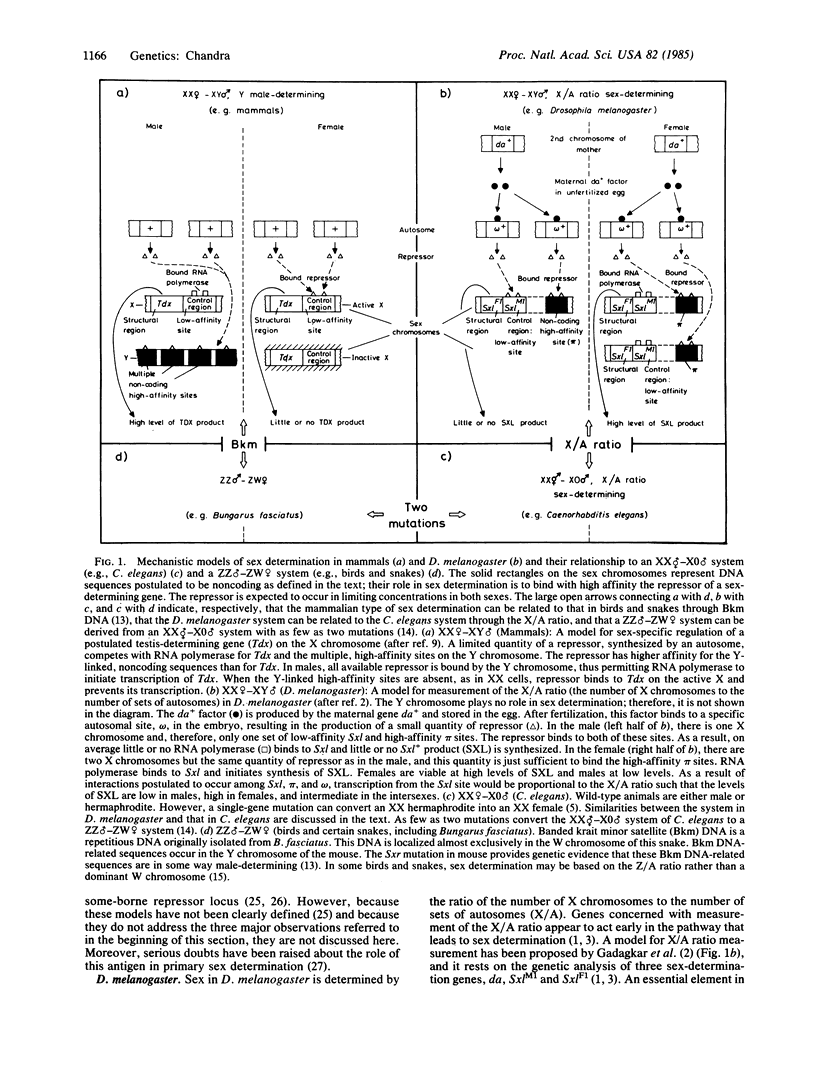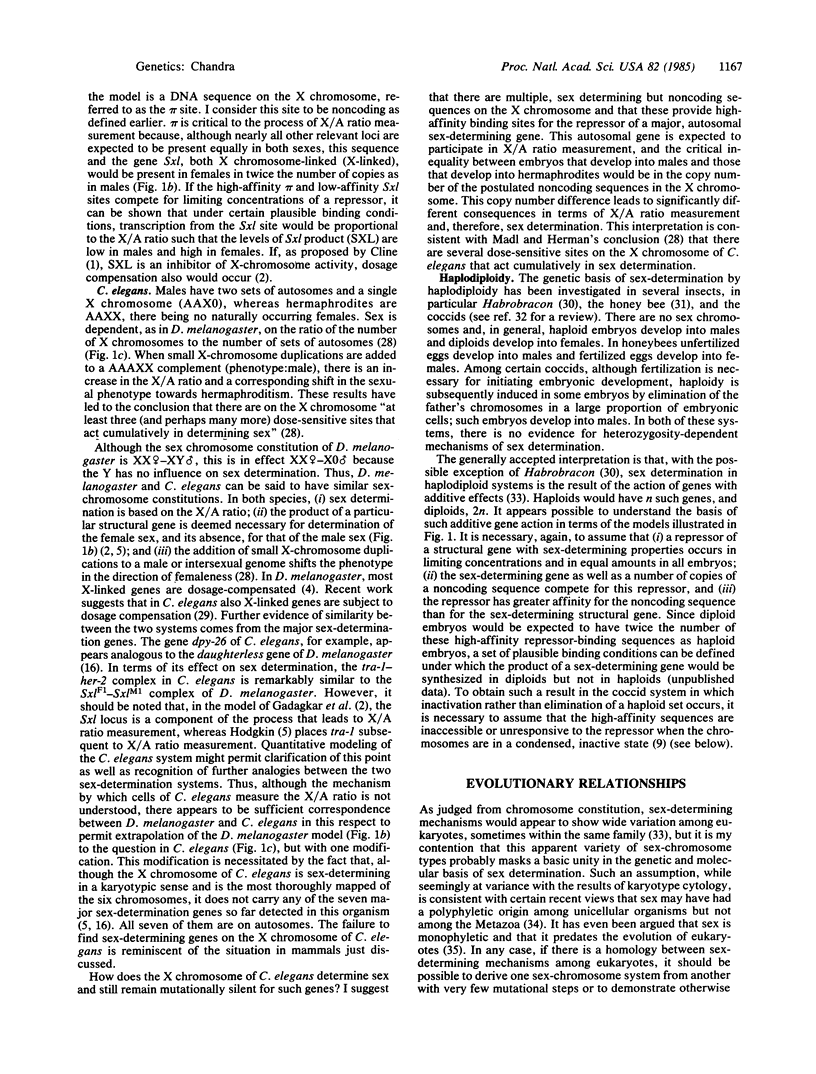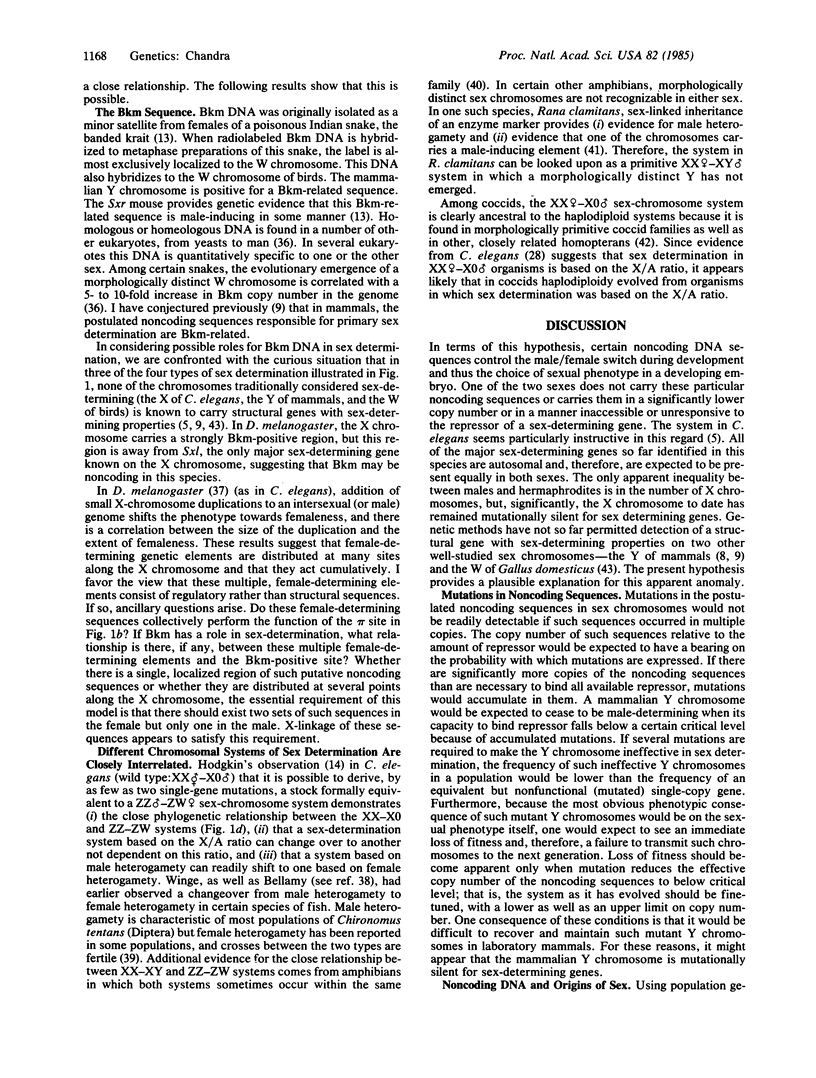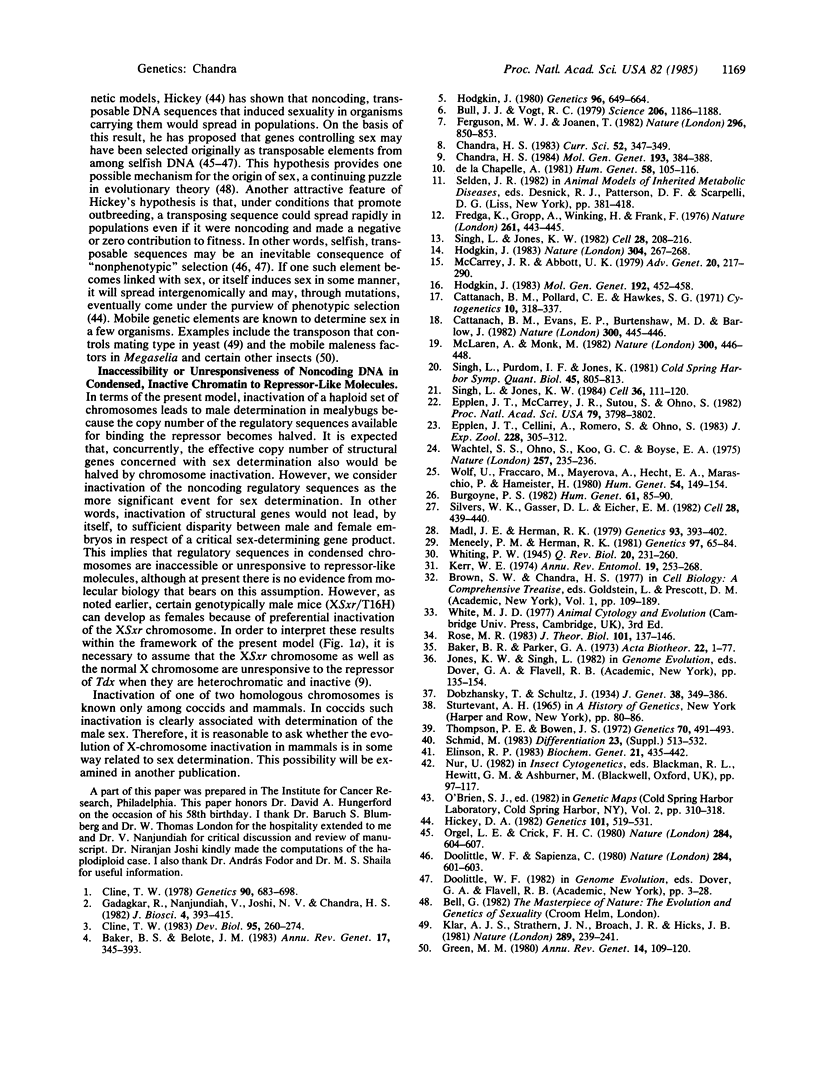Abstract
Certain recent models of sex determination in mammals, Drosophila melanogaster, Caenorhabditis elegans, and snakes are examined in the light of the hypothesis that the relevant genetic regulatory mechanisms are similar and interrelated. The proposed key element in each of these instances is a noncoding DNA sequence, which serves as a high-affinity binding site for a repressor-like molecule regulating the activity of a major "sex-determining" gene. On this basis it is argued that, in several eukaryotes, (i) certain DNA sequences that are sex-determining are noncoding, in the sense that they are not the structural genes of a sex-determining protein; (ii) in some species these noncoding sequences are present in one sex and absent in the other, while in others their copy number or accessibility to regulatory molecules is significantly unequal between the two sexes; and (iii) this inequality determines whether the embryo develops into a male or a female.
Full text
PDF




Selected References
These references are in PubMed. This may not be the complete list of references from this article.
- Baker B. S., Belote J. M. Sex determination and dosage compensation in Drosophila melanogaster. Annu Rev Genet. 1983;17:345–393. doi: 10.1146/annurev.ge.17.120183.002021. [DOI] [PubMed] [Google Scholar]
- Bull J. J., Vogt R. C. Temperature-dependent sex determination in turtles. Science. 1979 Dec 7;206(4423):1186–1188. doi: 10.1126/science.505003. [DOI] [PubMed] [Google Scholar]
- Burgoyne P. S. Genetic homology and crossing over in the X and Y chromosomes of Mammals. Hum Genet. 1982;61(2):85–90. doi: 10.1007/BF00274192. [DOI] [PubMed] [Google Scholar]
- Cattanach B. M., Evans E. P., Burtenshaw M. D., Barlow J. Male, female and intersex development in mice of identical chromosome constitution. Nature. 1982 Dec 2;300(5891):445–446. doi: 10.1038/300445a0. [DOI] [PubMed] [Google Scholar]
- Cattanach B. M., Pollard C. E., Hawker S. G. Sex-reversed mice: XX and XO males. Cytogenetics. 1971;10(5):318–337. doi: 10.1159/000130151. [DOI] [PubMed] [Google Scholar]
- Chandra H. S. A model for mammalian male determination based on a passive Y chromosome. Mol Gen Genet. 1984;193(3):384–388. doi: 10.1007/BF00382072. [DOI] [PubMed] [Google Scholar]
- Cline T. W. The interaction between daughterless and sex-lethal in triploids: a lethal sex-transforming maternal effect linking sex determination and dosage compensation in Drosophila melanogaster. Dev Biol. 1983 Feb;95(2):260–274. doi: 10.1016/0012-1606(83)90027-1. [DOI] [PubMed] [Google Scholar]
- Cline T. W. Two closely linked mutations in Drosophila melanogaster that are lethal to opposite sexes and interact with daughterless. Genetics. 1978 Dec;90(4):683–698. doi: 10.1093/genetics/90.4.683. [DOI] [PMC free article] [PubMed] [Google Scholar]
- Doolittle W. F., Sapienza C. Selfish genes, the phenotype paradigm and genome evolution. Nature. 1980 Apr 17;284(5757):601–603. doi: 10.1038/284601a0. [DOI] [PubMed] [Google Scholar]
- Elinson R. P. Inheritance and expression of a sex-linked enzyme in the frog, Rana clamitans. Biochem Genet. 1983 Jun;21(5-6):435–442. doi: 10.1007/BF00484436. [DOI] [PubMed] [Google Scholar]
- Epplen J. T., McCarrey J. R., Sutou S., Ohno S. Base sequence of a cloned snake W-chromosome DNA fragment and identification of a male-specific putative mRNA in the mouse. Proc Natl Acad Sci U S A. 1982 Jun;79(12):3798–3802. doi: 10.1073/pnas.79.12.3798. [DOI] [PMC free article] [PubMed] [Google Scholar]
- Ferguson M. W., Joanen T. Temperature of egg incubation determines sex in Alligator mississippiensis. Nature. 1982 Apr 29;296(5860):850–853. doi: 10.1038/296850a0. [DOI] [PubMed] [Google Scholar]
- Green M. M. Transposable elements in Drosophila and other Diptera. Annu Rev Genet. 1980;14:109–120. doi: 10.1146/annurev.ge.14.120180.000545. [DOI] [PubMed] [Google Scholar]
- Hickey D. A. Selfish DNA: a sexually-transmitted nuclear parasite. Genetics. 1982 Jul-Aug;101(3-4):519–531. doi: 10.1093/genetics/101.3-4.519. [DOI] [PMC free article] [PubMed] [Google Scholar]
- Hodgkin J. More sex-determination mutants of Caenorhabditis elegans. Genetics. 1980 Nov;96(3):649–664. doi: 10.1093/genetics/96.3.649. [DOI] [PMC free article] [PubMed] [Google Scholar]
- Hodgkin J. Two types of sex determination in a nematode. Nature. 1983 Jul 21;304(5923):267–268. doi: 10.1038/304267a0. [DOI] [PubMed] [Google Scholar]
- Klar A. J., Strathern J. N., Broach J. R., Hicks J. B. Regulation of transcription in expressed and unexpressed mating type cassettes of yeast. Nature. 1981 Jan 22;289(5795):239–244. doi: 10.1038/289239a0. [DOI] [PubMed] [Google Scholar]
- Madl J. E., Herman R. K. Polyploids and sex determination in Caenorhabditis elegans. Genetics. 1979 Oct;93(2):393–402. doi: 10.1093/genetics/93.2.393. [DOI] [PMC free article] [PubMed] [Google Scholar]
- McCarrey J. R., Abbott U. K. Mechanisms of genetic sex determination, gonadal sex differentiation, and germ-cell development in animals. Adv Genet. 1979;20:217–290. doi: 10.1016/s0065-2660(08)60547-7. [DOI] [PubMed] [Google Scholar]
- McLaren A., Monk M. Fertile females produced by inactivation of an X chromosome of "sex-reversed' mice. Nature. 1982 Dec 2;300(5891):446–448. doi: 10.1038/300446a0. [DOI] [PubMed] [Google Scholar]
- Meneely P. M., Herman R. K. Suppression and function of X-linked lethal and sterile mutations in Caenorhabditis elegans. Genetics. 1981 Jan;97(1):65–84. doi: 10.1093/genetics/97.1.65. [DOI] [PMC free article] [PubMed] [Google Scholar]
- Orgel L. E., Crick F. H. Selfish DNA: the ultimate parasite. Nature. 1980 Apr 17;284(5757):604–607. doi: 10.1038/284604a0. [DOI] [PubMed] [Google Scholar]
- Rose M. R. The contagion mechanism for the origin of sex. J Theor Biol. 1983 Mar 7;101(1):137–146. doi: 10.1016/0022-5193(83)90277-1. [DOI] [PubMed] [Google Scholar]
- Silvers W. K., Gasser D. L., Eicher E. M. H-Y antigen, serologically detectable male antigen and sex determination. Cell. 1982 Mar;28(3):439–440. doi: 10.1016/0092-8674(82)90197-0. [DOI] [PubMed] [Google Scholar]
- Singh L., Jones K. W. Sex reversal in the mouse (Mus musculus) is caused by a recurrent nonreciprocal crossover involving the x and an aberrant y chromosome. Cell. 1982 Feb;28(2):205–216. doi: 10.1016/0092-8674(82)90338-5. [DOI] [PubMed] [Google Scholar]
- Singh L., Phillips C., Jones K. W. The conserved nucleotide sequences of Bkm, which define Sxr in the mouse, are transcribed. Cell. 1984 Jan;36(1):111–120. doi: 10.1016/0092-8674(84)90079-5. [DOI] [PubMed] [Google Scholar]
- Singh L., Purdom I. F., Jones K. W. Conserved sex-chromosome-associated nucleotide sequences in eukaryotes. Cold Spring Harb Symp Quant Biol. 1981;45(Pt 2):805–814. doi: 10.1101/sqb.1981.045.01.099. [DOI] [PubMed] [Google Scholar]
- Thompson P. E., Bowen J. S. Interactions of differentiated primary sex factors in Chironomus tentans. Genetics. 1972 Mar;70(3):491–493. doi: 10.1093/genetics/70.3.491. [DOI] [PMC free article] [PubMed] [Google Scholar]
- Wachtel S. S., Ono S., Koo G. C., Boyse E. A. Possible role for H--Y antigen in the primary determination of sex. Nature. 1975 Sep 18;257(5523):235–236. doi: 10.1038/257235a0. [DOI] [PubMed] [Google Scholar]
- Wolf U., Fraccaro M., Mayerová A., Hecht T., Maraschio P., Hameister H. A gene controlling H-Y antigen on the X chromosome. Tentative assignment by deletion mapping to Xp223. Hum Genet. 1980;54(2):149–154. doi: 10.1007/BF00278963. [DOI] [PubMed] [Google Scholar]
- de la Chapelle A. The etiology of maleness in XX men. Hum Genet. 1981;58(1):105–116. doi: 10.1007/BF00284157. [DOI] [PubMed] [Google Scholar]


